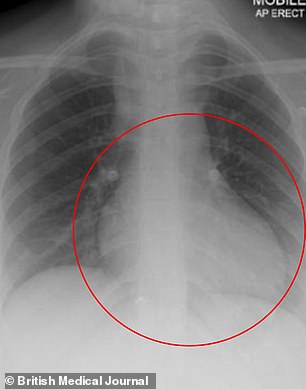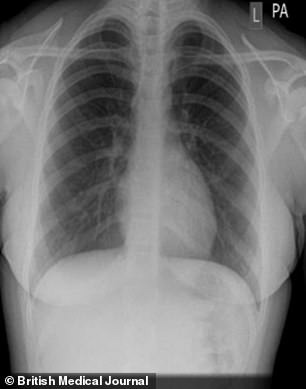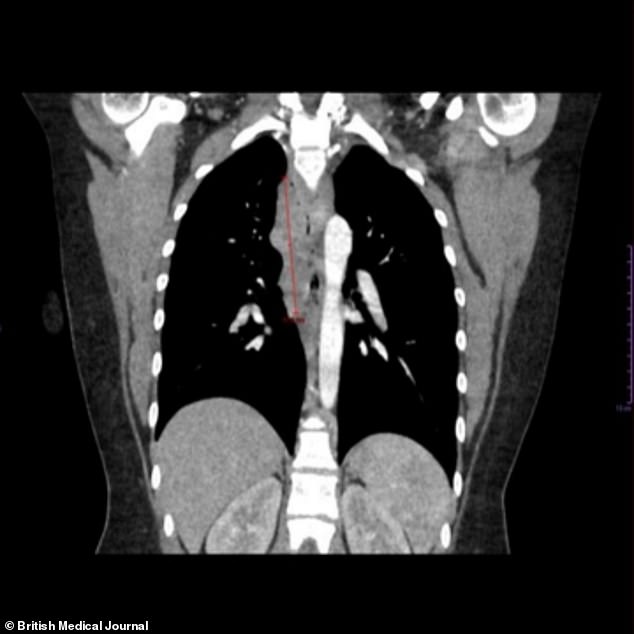A woman who suspected she was having an asthma attack was actually suffering from symptoms of undiagnosed blood cancer.
The anonymous woman, who was in her early 20s and from the UK, was generally considered healthy except for being diagnosed with asthma when she was nine years old.
Suffered by about one in 12 Americans, or 25million people, asthma is a respiratory condition that causes the airways to narrow and swell, making it difficult to breathe.
Earlier this year, the woman arrived at her local hospital after 24 hours of suffering from ‘significant respiratory distress,’ including worsening breathlessness, wheezing and tightness in her chest, classic signs of an asthma attack.
Despite receiving oxygen, corticosteroids and nebulizer treatments, which turn liquid medications into inhaled mist, her oxygen dropped dangerously low to 78 percent, a sign of respiratory failure.
Doctors were forced to intubate the woman, which involves inserting a tube into the trachea, and place her on a ventilator to help her breathe.
X-rays revealed mediastinal widening, an enlarged space between the lungs, and that her trachea had shifted positions due to a mass that had grown in the mediastinum, the central part of the chest cavity between the lungs and the heart, and spread to the esophagus.
After taking a biopsy of the mass, doctors diagnosed the woman with stage three nodular sclerosing Hodgkin lymphoma (NSHL), a type of cancer affecting the white blood cells in the lymph nodes.

A woman in the UK with symptoms of an asthma attack actually had lymphoma, doctors wrote in a medical journal (stock image)
Your browser does not support iframes.
Doctors treating the woman, from Luton and Dunstable University Hospital in the UK, wrote in the British Medical Journal that lymphoma presenting as an asthma attack is ‘rare,’ and because the cancer mimics asthma, there can be delays in diagnosis, worsening the chance of survival.
The team wrote: ‘Acute severe asthma was the primary working diagnosis given the characteristic symptoms of wheezing, chest tightness and respiratory distress.
‘Yet, the lack of clinical improvement despite optimal therapy, including progression to respiratory failure, raised suspicion that an alternative or additional pathology might be contributing.’
Lymphoma affects about 90,000 Americans every year and kills 20,000.
Hodgkin lymphoma makes up about one in 10 of those cases and deaths, and about 70 percent of people with Hodgkin lymphoma have NSHL.
The majority of people with NSHL are young, like the unnamed patient, with most cases diagnosed in between 15- and 34-year-olds, researchers estimate.
Additionally, 80 percent of NSHL patients have a mass in the mediastinal area, like the patient.
Respiratory symptoms like wheezing and trouble breathing, however, are uncommon, and patients typically suffer fevers, night sweats, unintended weight loss and fatigue.


The chest x-ray on the left shows the woman’s widened mediastinum and shifted trachea from a tumor in her chest cavity. The image on the right taken 11 years prior shows a normal x-ray

The red line on the above CT scan shows the mass in the woman’s mediastinal region
The doctors treating the woman wrote: ‘While similar presentations have been documented, reports of [Hodgkin lymphoma] in this age group with acute airway obstruction mimicking severe asthma remain uncommon.’
Even when Hodgkin lymphoma spreads, the five-year-survival rate is about 84 percent, according to the American Cancer Society.
The woman received the IV corticosteroid dexamethasone to reduce swelling and compression in her airway. At the time of the case study’s publication earlier this month, the woman was still receiving chemotherapy.
Her medical team urged physicians to perform imaging tests early on if asthma treatment fails to catch lymphoma before it spreads.
The physicians wrote: ‘Not all that wheezes is asthma; consider structural airway causes in refractory cases.
‘Hodgkin lymphoma can present acutely with airway obstruction mimicking asthma.’
